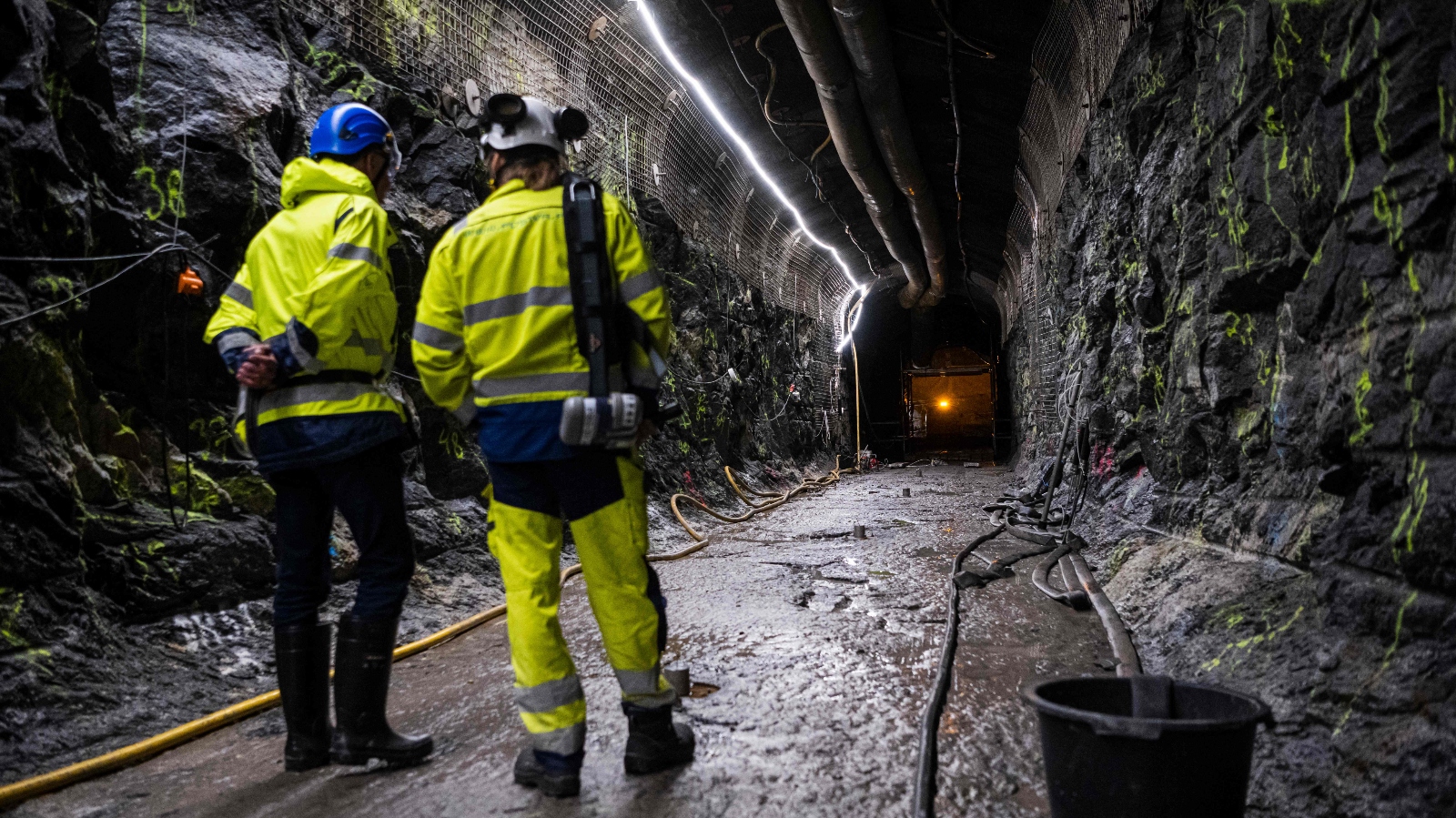The world’s first permanent depository for nuclear fuel waste opens later this year on Olkiluoto, a sparsely populated and lushly forested island in the Baltic Sea three hours north of Helsinki.
Onkalo — the name means “cavity” or “cave” in Finnish — is among the most advanced facilities of its kind, designed for an unprecedented and urgent task: safely storing some of the most toxic material on Earth nearly 1,500 feet underground in what’s called a deep mined geologic repository.
The process requires remarkable feats of engineering. It begins in an encapsulation plant, where robots remove spent nuclear fuel rods from storage canisters and place them in copper and cast iron casks up to two stories tall. Once full, these hefty vessels, weighing around 24 metric tons, will descend more than a quarter-mile in an elevator to a cavern hollowed out of crystalline bedrock 2 billion years old. (The trip takes 50 minutes.) Each tomb will hold 30 to 40 of these enormous containers ensconced in bentonite clay and sealed behind concrete. As many as 3,250 canisters containing 6,500 metric tons of humanity’s most dangerous refuse will, the theory goes, lie undisturbed for hundreds of thousands of years.
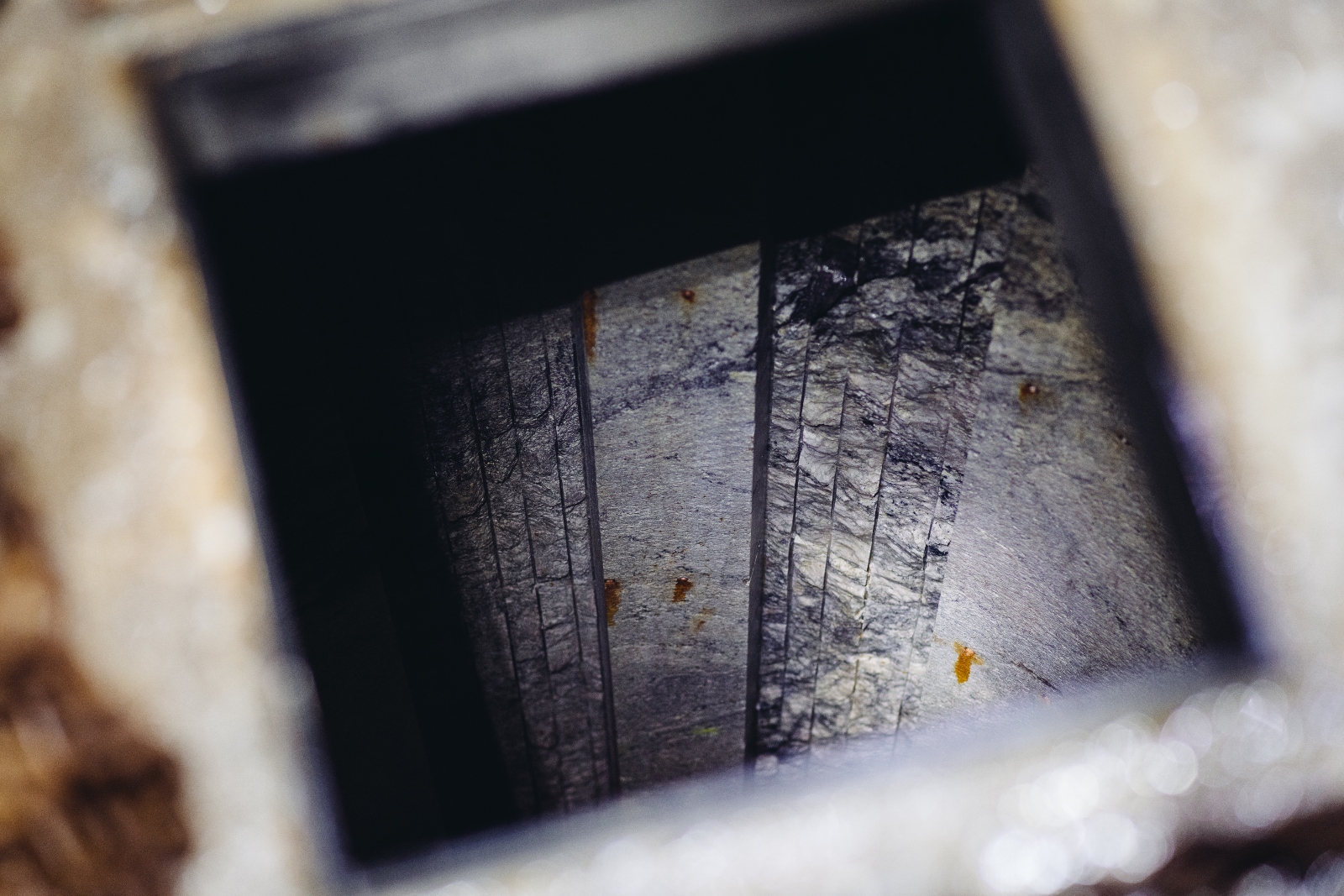
Nothing assembled by human hands has stood for more than a fraction of that. The world’s oldest known structure, Gobekli Tepe in Turkey, is a bit more than 11,000 years old. Designing Onkalo to endure for so unfathomably long is necessary because the material left behind by nuclear fission remains radioactive for millennia. Safely disposing of it requires stashing it for, essentially, eternity. That way nothing — be it natural disasters, future ice ages, or even the end of humanity itself — would expose anyone, or anything, to its dangers.
“The plan is that there will be no sign [of the facility],” said Pasi Tuohimaa, communications manager for Posiva, the agency that manages Finland’s nuclear waste. “Nobody would even know it’s there, whether we’re talking about future generations or future aliens or whatever.”
Building such a place, as technologically complex as it is, might be easier than convincing a community to host it. Gaining that approval can take decades and rests upon a simple premise.
“One of the principles of geologic disposal is the idea that the generations that enjoy the benefits of nuclear power should also pay for and participate in the solution,” said Rodney Ewing, a mineralogist and materials scientist at Stanford University and co-director of the university’s Center for International Security and Cooperation.
The long process of gaining such support is called consent-based siting, an undertaking many in the nuclear energy sector consider vital as the world abandons fossil fuels. Nuclear power accounts for almost a fifth of the United States’ electricity generation, and its expansion is among the few elements of the Biden administration’s energy agenda that enjoys strong bipartisan support. Over the last year, Energy Secretary Jennifer Granholm has touted the nation’s newest reactor, celebrated plans for an experimental small modular reactor, and unveiled a $1.5 billion loan to restart a defunct plant in Michigan.
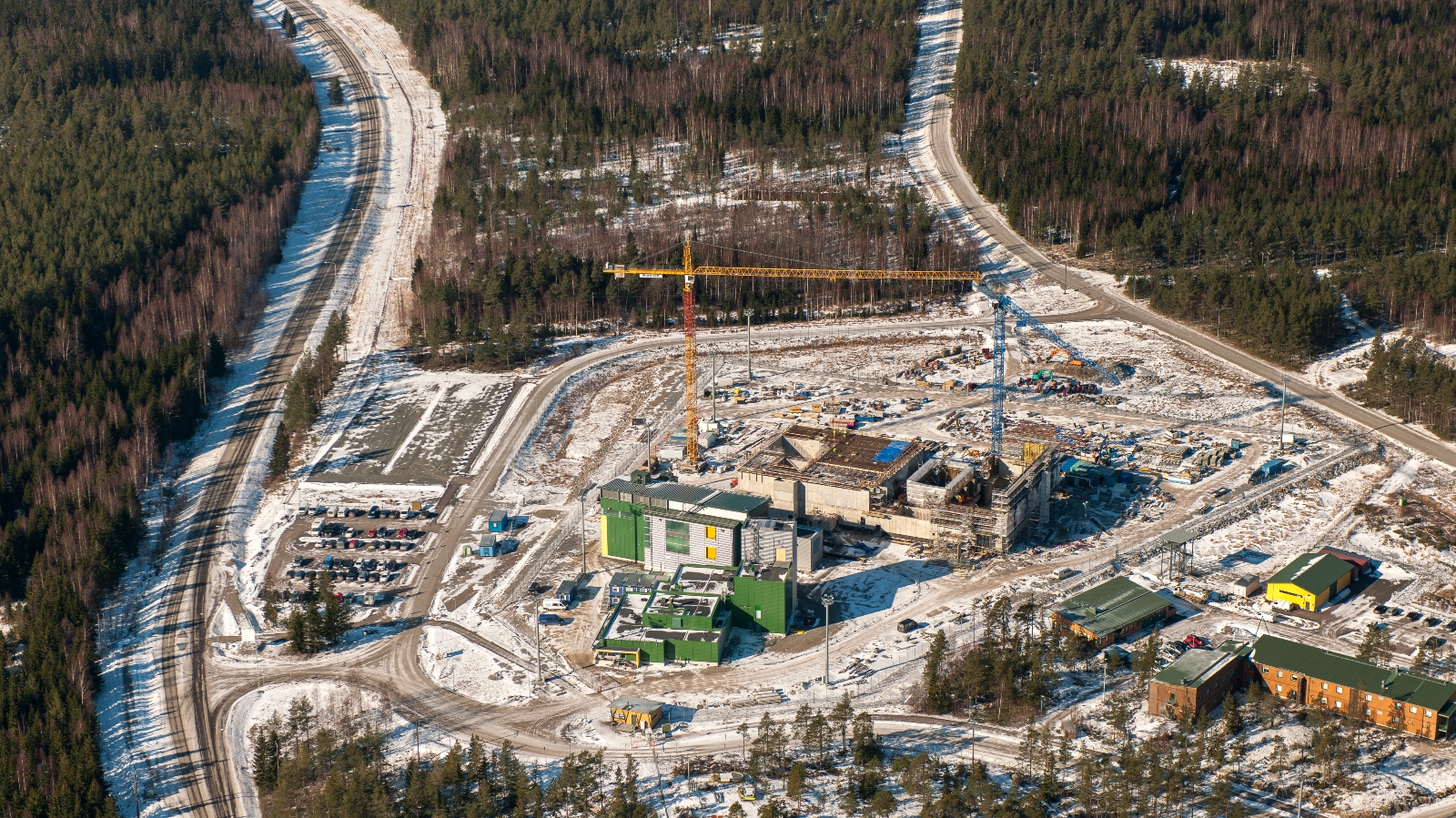
These are hardly one-offs. The U.S. intends to triple its nuclear energy capacity by 2050. Yet experts say there isn’t enough public discussion of how to deal with the corresponding increase in radioactive trash, which will compound a problem the country has deferred since the start of the nuclear age. After botching plans for a deep mined geological repository a generation ago, the United States is scrambling to catch up to Finland and several other nations, including Canada, which could choose a site by year’s end.
As the U.S. races toward a post-carbon future in which nuclear energy could play a key role, policymakers, energy experts, and community leaders say dealing with the inevitable waste isn’t a technical problem, but a social one. Engineers know how to build a repository capable of safeguarding the public for millennia. The bigger challenge is convincing people that it’s safe to live next to it.
The United States knew, even before the world’s first commercial nuclear power plant began operating in Pennsylvania in 1957, how best to dispose of the effluvium generated by splitting atoms to generate electricity. Earlier that year, geologists and geophysicists wrote a National Academy of Sciences report that proposed burying it. Opinions haven’t changed much in the 67 years since.
“The only viable way to possibly deal with the issue of isolating radioactive waste that can remain hazardous for hundreds of thousands of years from the environment is a deep geologic repository,” said Edwin Lyman, director of nuclear power safety at the Union of Concerned Scientists. “There’s really no alternative.”
Yet this refuse, most of it from the nation’s 54 commercial reactors, remains in what amounts to cold storage. Depleted fuel rods are kept on-site in water tanks for about half a decade, then moved to steel and concrete canisters called dry casks and held for another 40 years in what’s known as interim storage. Only then is the material cool enough to stash underground. That last step has never happened, however. The nation’s 85 interim storage sites hold more than 86,000 tons of waste, a situation that’s akin to leaving your trash behind the garage indefinitely. The situation could grow more dire as the nation invests in advanced small modular reactors.
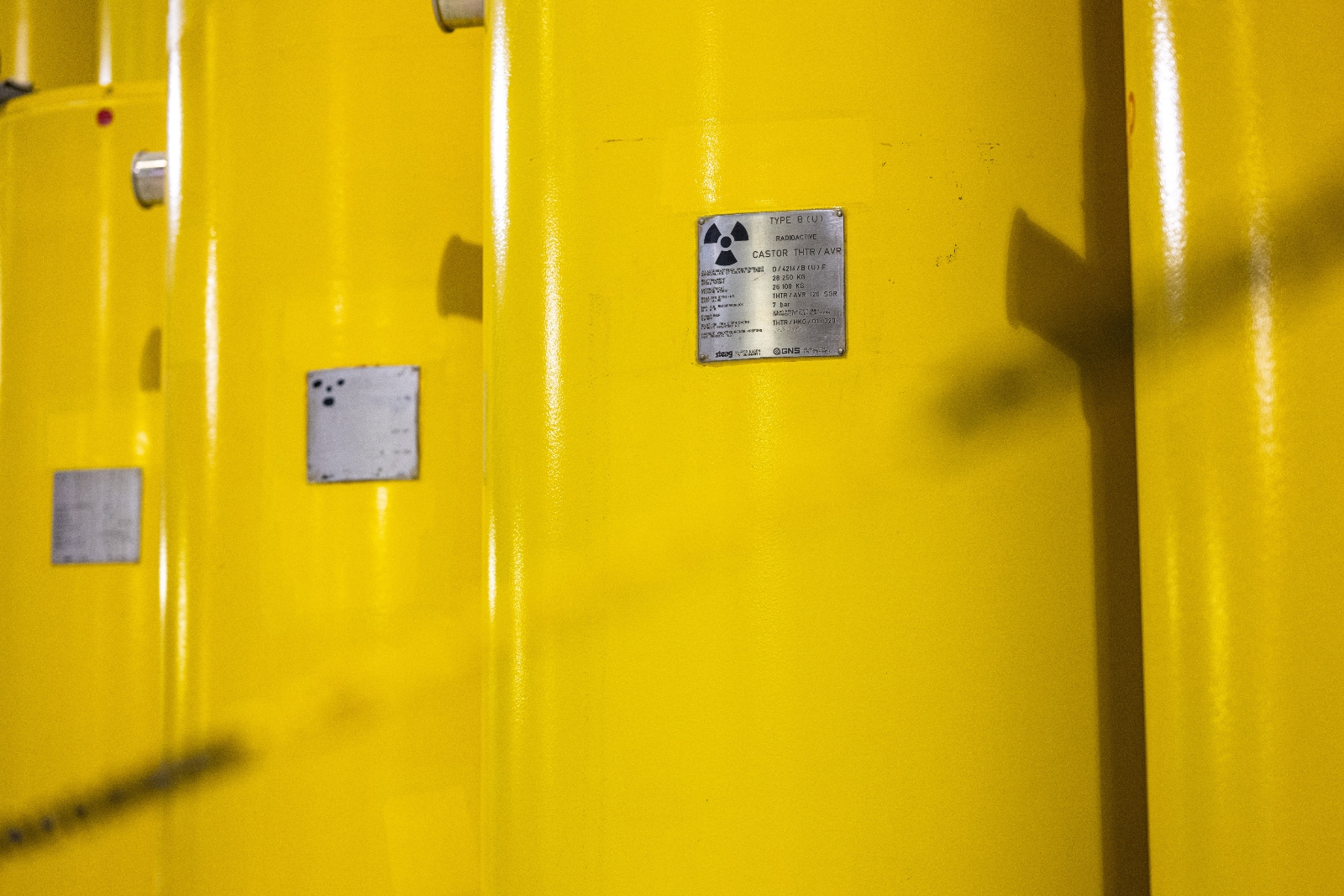
“It’s a pet peeve of mine, to be honest,” said Paul Murray, who became the Department of Energy’s deputy assistant secretary for spent fuel and waste disposition in October. “Everybody talks about the shiny new reactors, but nobody ever talks about back-end management of the fuel that comes out of them.”
Congress attempted to rectify that in 1982 when it passed the Nuclear Waste Policy Act. President Ronald Reagan called the law “an important step in the pursuit of the peaceful uses of atomic energy.” It required that the federal government begin taking responsibility for the nation’s nuclear waste by 1998, and that the utilities generating it pay a fee of one-tenth of a cent per kilowatt-hour of nuclear-generated electricity to be rid of it. The plan stalled because the government never took possession of most of the waste. That failure has allowed the utilities to collect $500 million in fines from Washington each year since 1998. A report that the Government Accountability Office released in 2021 noted that federal liabilities could reach $60 billion by 2030.
The federal government’s missteps continued when plans for a deep geologic repository derailed about 15 years ago. The 1982 law directed the Department of Energy to provide the president, Congress, the Nuclear Regulatory Commission, and the Environmental Protection Agency with suggestions for several sites. Congress amended the law in 1987 to designate one: Yucca Mountain, about 100 miles northwest of Las Vegas on land the Western Shoshone Nation considers sacred.
This top-down process was the antithesis of consent-based siting, and it collapsed amid community opposition and the efforts of then-Senate Majority Leader Harry Reid. The Nevada Democrat convinced President Obama to scuttle the proposal, which by that point had cost $13 billion. The Obama administration convened a panel of scientists to devise a new plan; in 2012, it suggested creating an independent agency, giving it responsibility for the nuclear fund and directing it to revamp the effort through consent-based siting.
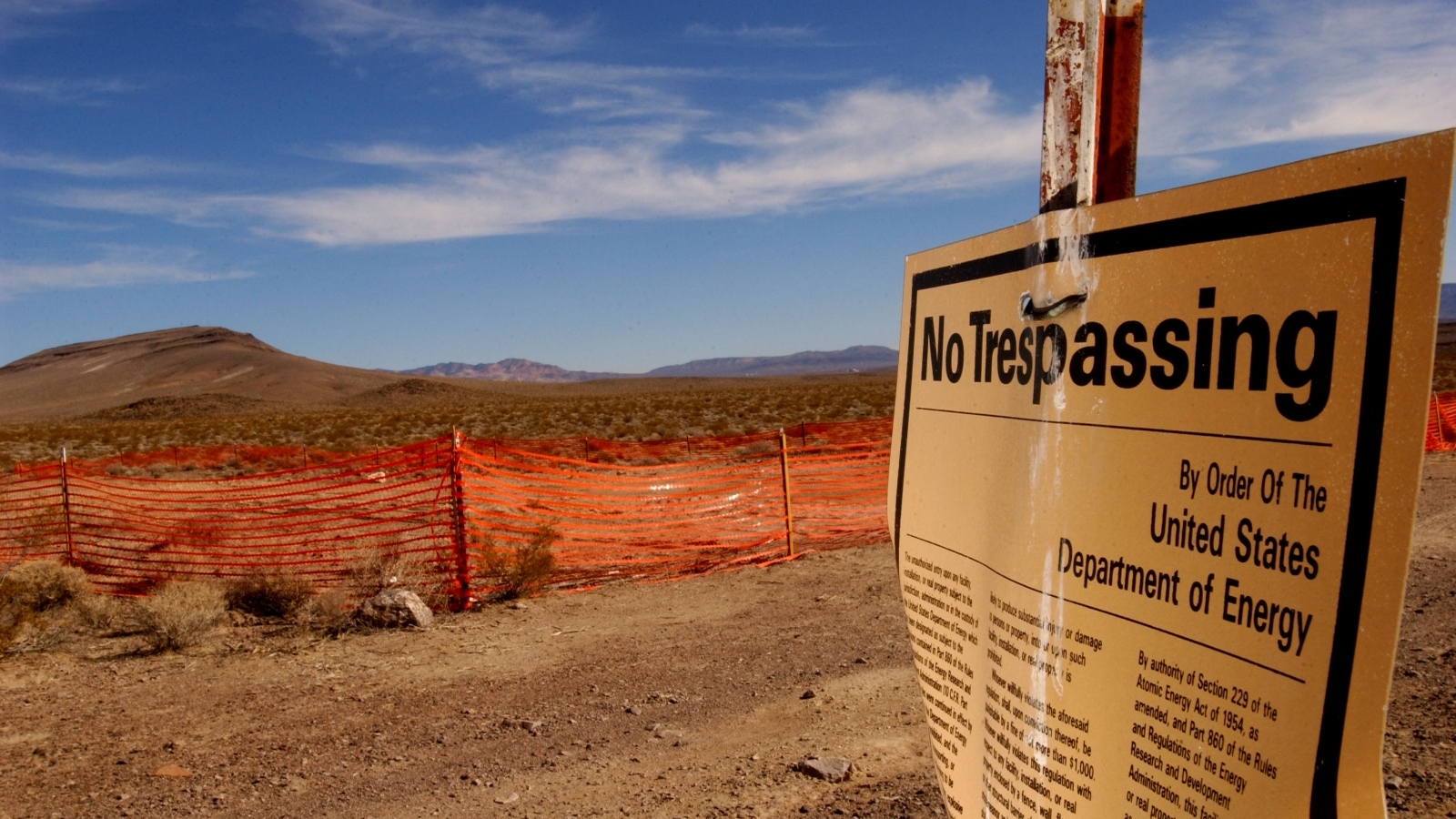
That recommendation mimicked what Finland had done, and Canada was doing, to build community consensus. Posiva spent four decades working toward the facility on Olkiluoto; the Canadian search started 24 years ago with the creation of the independent Nuclear Waste Management Organization. Yet more than 10 years after the Department of Energy made consent-based siting its official policy, there’s been little progress toward a deep mined geologic repository in the U.S. for commercial nuclear waste. (Radioactive refuse generated by the defense industry has, since 1999, been secured 2,150 feet underground at the Waste Isolation Pilot Plant in New Mexico.)
Instead of identifying possible sites for a deep geologic repository, the Energy Department directed Murray, who has a background in nuclear technology and environmental stewardship, to address a backlog of waste that could, by his estimate, take 55 years to clear out of interim storage. Much of this trash is languishing in dry casks that dot power plants in 37 states. Last year, he formed a 12-member Consent-Based Siting Consortia to start the search for a federally-managed site that would temporarily consolidate the nation’s waste until a permanent site is built.
He could start by looking at existing energy communities with coal-fired power plants that have been decommissioned or soon will be, according to Kara Colton. She leads the Energy Communities Alliance, a coalition of local governments that is part of the consortia and is distributing $1 million in federal grants to three communities interested in hosting a nuclear waste storage facility. (Additional grants will be available this summer.) But she worries that, without a concerted, long-term effort by the government to find a permanent repository, no one will commit to participating.

“This is a multi-generational project and we have a political system that changes all the time,” she said. “Without assured funding, we’re checking every year to see if the progress that’s made will change.”
But Murray’s quest to consolidate temporary waste storage may be moot. Under the Nuclear Waste Policy Act, the Department of Energy lacks the authority to designate an interim storage site unless that facility is tied to a plan to establish a deep mined geologic repository. That makes Murray’s efforts “pretty meaningless,” Lyman said.
Murray concedes that his mission faces challenges. “Without a robust repository program, it’s very difficult to site interim storage,” he said. “We have to, as a nation, start a repository program, otherwise people think they’ll become the de facto disposal facility.”
Gaining consensus for a permanent storage site, then building it, could take 50 years, he said. In the meantime, the nation’s utilities continue to pile up 2,000 metric tons of nuclear waste each year.
If 50 years sounds preposterous, consider that Finland began its search for a repository site in 1983. Within a decade, the government had considered four locations in a process that weighed community opinions alongside geological and environmental criteria like bedrock density, groundwater movement, and potential changes in the movement and formation of the glaciers above due to climate change.
Eurajoki, a rural village of just over 9,000 people, provided the greatest social support and the best geographical factors. When the town council voted to approve the site in 2000, its members, and many residents, seemed predisposed to the idea because Olkilouto, which is 8 miles away, already hosted two reactors. (A third, Olkiluoto 3, opened in April 2023; the three plants provide about one-third of the country’s electricity.)
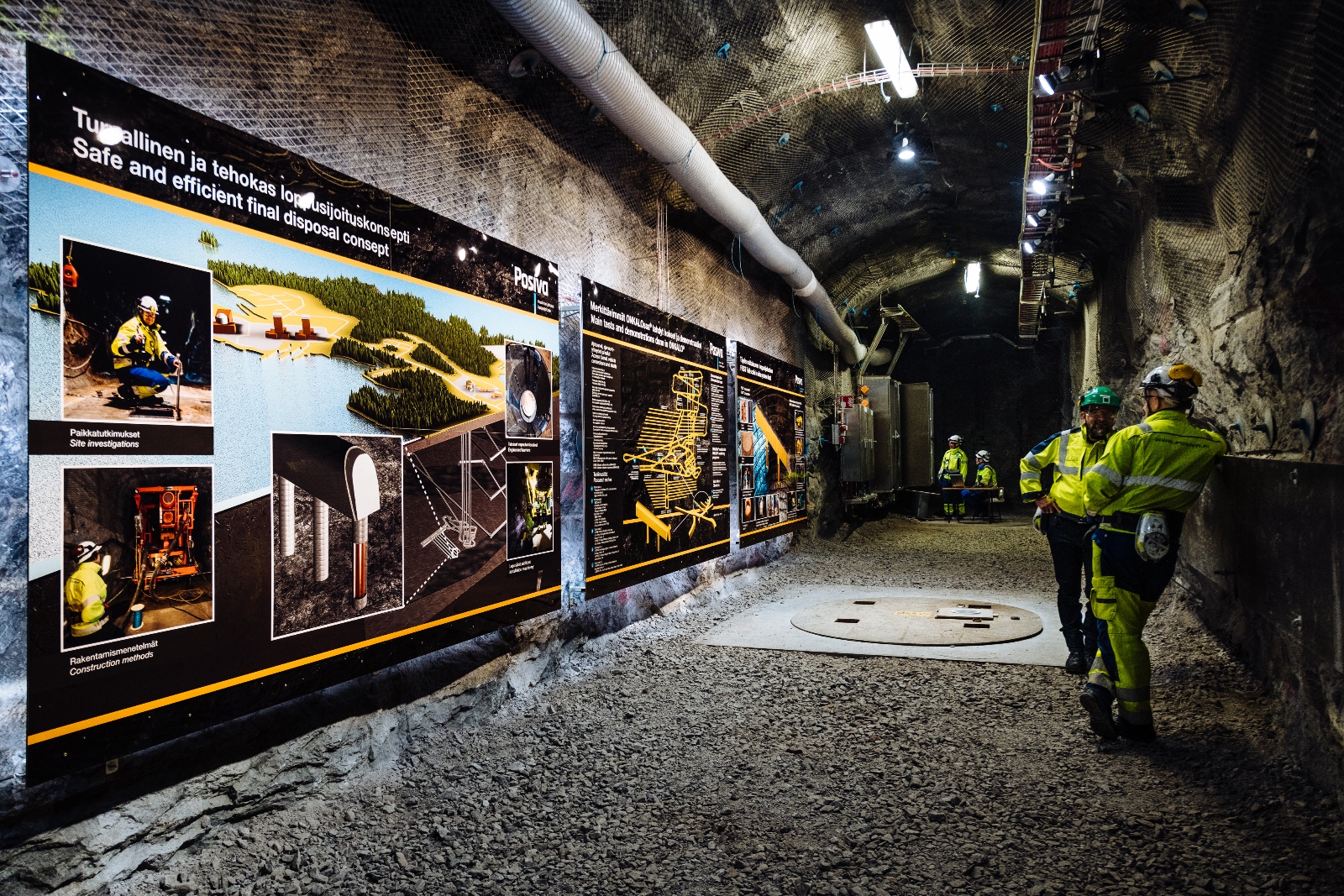
Still, Posiva, the independent agency charged with establishing a deep geologic repository, engaged in a long-term campaign to foster community support and trust, teaching residents about nuclear energy and waste storage to alleviate their concerns. Tuohimma, Posiva’s communications manager, called it a “long road show” with origins in the company’s efforts to sell the technology in the 1970s. Although the Finnish Green Party and Greenpeace expressed concerns about the project — stemming from the building of new nuclear plants and not disposal of the waste — opposition has since eased. Construction of the 1 billion euro facility started in 2000; Posiva estimates that over the next century, running, filling, and eventually sealing the site will cost 5.5 billion euros. How long that takes will depend upon the rate at which the country generates radioactive waste.
Eurajoki Mayor Vesa Lakaniemi told German news site DW that hosting all that nuclear infrastructure generates about 20 million euros in taxes each year. That’s almost half the town’s annual revenue and is “how we can plan our future investments,” including a renovated school, a new library, and an 8 million euro sports facility. Lakaniemi believes residents ultimately supported the project because of Posiva’s safety record, and because Finns tend to trust their government and its institutions.
Canada’s efforts have not gone so smoothly.
The country’s hunt for a site began in 2002 when parliament passed the Nuclear Fuel Waste Act. The law established the Nuclear Waste Management Organization, or NWMO, which unveiled a nine-step plan in 2010 that would lead, within a decade or so, to an agreement to host a repository. Within two years, 21 communities had expressed interest in doing just that.
The agency spent the past dozen years winnowing the list to the two most geologically and socially appropriate sites. To do that, it began by ensuring each candidate had a suitable site — one large enough for the required infrastructure, yet far enough from drinking water supplies and protected lands like national parks. Communities also had to outline the material benefits they would receive from the employment opportunities and industrial development the project would foster.
Over time, the screening process cut the list of potential sites to two. The first is South Bruce, a small farming community roughly 100 miles west of Toronto and about 35 miles from the country’s largest nuclear power plant. The other is Ignace, a rural town about 150 miles northwest of Lake Superior.

The First Nations communities in those locations — the Saugeen Ojibway Nation near South Bruce and the Wabigoon Lake Ojibway Nation near Ignace — also must provide consent, but that process is separate, and generally less publicized, from those taking place in the townships.
The site near Ignace sits on what is roughly equivalent to federal land, which makes acquisition easier than in South Bruce, where the Nuclear Waste Management Organization had to sign agreements with property holders to eventually purchase their land for the 1,500-acre project, should it go through. That meant selling the idea not only to the community, but to individual landowners. The agency gained support by spending liberally to help the town with everything from new fire trucks to a scholarship fund to paying some municipal salaries. All told, it has given the town more than $9.3 million since 2013. (Ignace has received almost $14 million since 2018.)
Still, the idea of hosting a repository has divided the 6,000 or so residents in South Bruce, who were once united by their participation in church groups and youth sports. Supporters say they trust the science showing that repository technology is safe, and they point to the benefits it’s already brought. But critics worry about the impact of all that radioactive material on the town now and decades into the future, and they worry the potential economic and environmental costs haven’t been adequately studied. They also feel the NWMO is less interested in considering their perspectives and answering their questions than in selling the repository through fiscal promises.
Carolyn Fell, the agency’s communications manager in South Bruce, said residents can find her in the office five days a week, where she is happy to answer questions. “We have heard concerns from the community, and at every turn we do our best to answer in a very up-front and transparent way,” she said.
Michelle Stein isn’t so sure about that. She and her husband Gary raise cattle and sheep on a farm they bought in South Bruce 30 years ago. They also raise three children there, with dreams of them taking over. But after NWMO started signing agreements with adjacent landowners for what would become 1,500 acres back in 2019, Stein’s kids moved away. Now, she worries her land could soon be worthless and her livelihood gone.
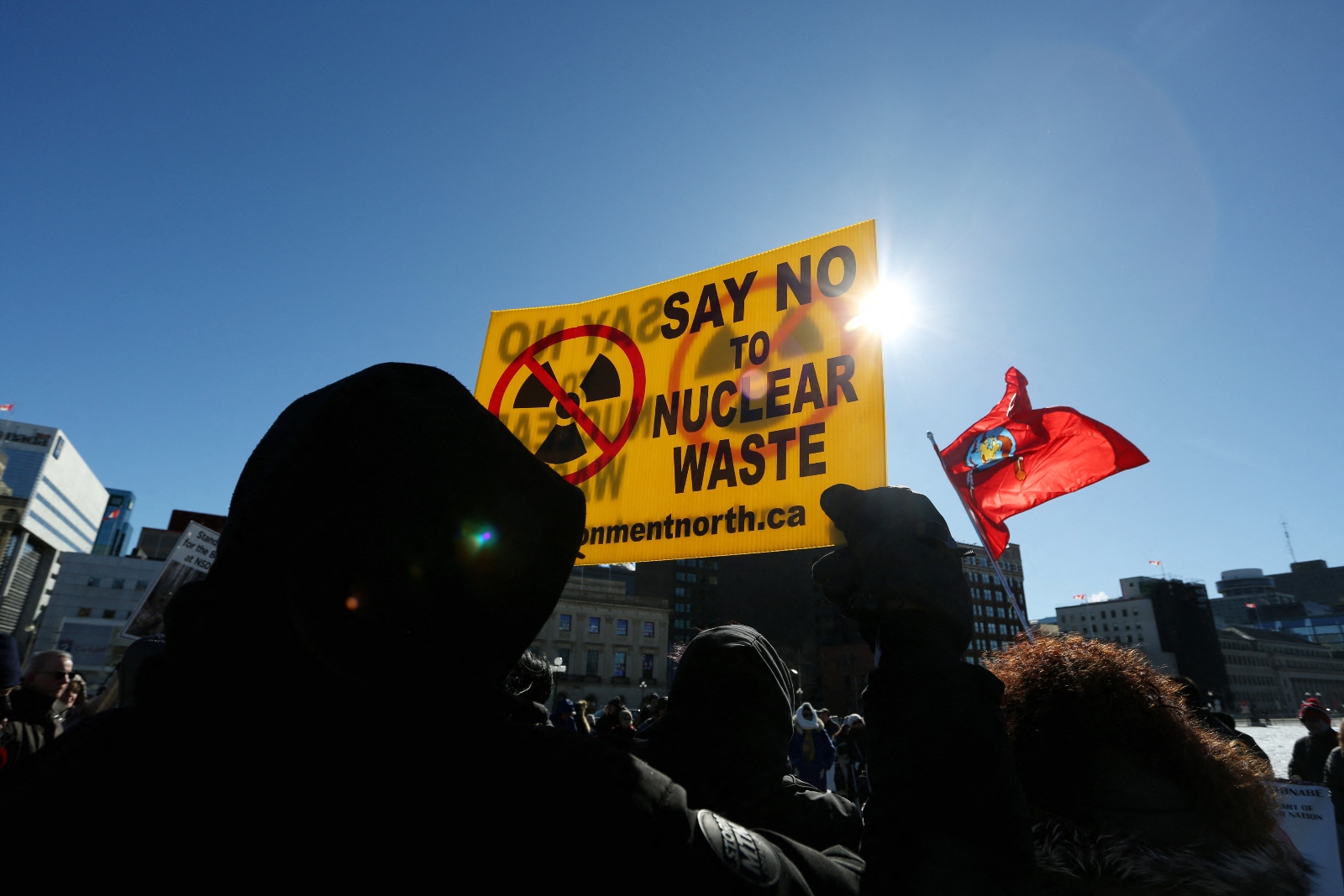
“In my opinion, they should at least pay us what they paid people who sold at the beginning of the project,” Stein said. She also fears the impact the facility might have on groundwater, and whether anyone would buy beef and lamb grown alongside a nuclear site. She feels some of her neighbors, and the town council, have been bought off by NWMO’s investments in the community.
“They say they won’t come into a non-willing community,” Stein said, “but they’re certainly pushing us to be willing.”
Stein joined more than a dozen others in organizing Protect Our Waterways to oppose the project. The group’s volunteer chair, Anja Vandervlies, worries the buffer zone, which prohibits living or farming within a certain distance of the facility, might end up including some or all of her farm. She and Stein have testified before the town council, written op-eds for the local paper, and erected bright yellow, handmade billboards reading, “Say No to NWMO” and “Stop Canada’s Nuke Dump!” But they have felt crowded out by what they considered aggressive marketing by the agency. In 2022, their field of candidates for town council fared poorly in the election; Mayor Mark Goetz said he and the body’s five elected members now publicly support the waste facility.
Goetz succeeded his father, who was mayor in 2012 when South Bruce told the Nuclear Waste Management Organization it was interested in hosting the repository. Goetz said his father was interested in the economic development the project would bring to a community heavily dependent on agriculture. He rejects claims that the town council has not sought community input, noting that it has held hundreds of events over the past 12 years. He’s also grateful for the financial support the NWMO has provided thus far. More than that, however, he believes someone has to host the site, so why not South Bruce?
“We’ve benefited from cheap nuclear power, and I don’t think we should leave this waste to sit for future generations to deal with,” Goetz said.
Voters will decide the matter in a referendum in October. More than 50 percent of voters must cast ballots for it to count, which, to Goetz’s mind, makes the council’s position largely moot.
“The beauty of the referendum is that everyone gets an equal vote,” he said. “It’s a democracy, and it’ll be majority rule, so it doesn’t really matter which way the council decides.”
But if the referendum brings out less than 50 percent of voters, the decision falls back to the town council.
A win in South Bruce won’t necessarily be enough, though, because the Saugeen Ojibway Nation also must endorse the idea. Even then, the Nuclear Waste Management Organization will make the final decision later this year, and it also has an eye on the location near Ignace.
That option, called the Revell site, sits about midway between Ignace and the larger town of Dryden. Vince Ponka, the agency’s regional communications manager for northern Ontario, described it as an egg-shaped formation of granite several miles long and deep within the Canadian Shield, a vast igneous and metamorphic formation that rings Hudson Bay.
“It’s an ideal piece of rock to hold the [deep mined geologic repository],” he said. Although the facility would be beyond the city limits, Ignace would host the “Center of Expertise,” an office and educational complex meant to teach people about the repository. He called it a “real architectural gem” that could boost economic development.
Jodie Defeo, a registered nurse and an Ignace town council member, said she was indifferent when she learned about the possibility of a repository 14 years ago, but any skepticism was allayed last summer during a trip to Olkiluoto that the Nuclear Waste Management Organization funded.

“There was no sense of caution or anything, it appeared like there was no cause for concern” among the people of Eurajoki, she said. She saw the improvements the tax revenue made in the local schools and infrastructure, and she returned home a booster. She believes a similar facility could bring good fortune to Ignace, which fell upon hard times when the mining industry began to dwindle a few decades ago.
“There are no pots of money for aging infrastructure,” she said. Few jobs, a tanking housing market, and a dwindling population result in a tiny tax base. While her 17-year-old son is interested in staying in Ignace, her 27-year-old son moved to Thunder Bay, a city of roughly 110,000 almost three hours south on the shore of Lake Superior. For Defeo, the possibility of hosting a repository brings with it a sense of hope.
“I feel like we could be on the cusp of a change,” she said.
Wendy O’Connor doesn’t share her optimism. She’s the communications officer for Thunder Bay and volunteers with the opposition group We the Nuclear Free North. She said that although Ignace raised its hand to host the repository, all the waste will pass through her city. The trucks carrying it will trundle about 1,000 miles along the Trans Canada Highway, a largely two-lane road that hugs the coast of Lake Huron and the cliffs of Lake Superior. She’s worried about the risk of accidents on the highway or at the site.
Of course, there is always the risk that radioactive material will leak while in transit or short-term storage, something that has happened in Germany and New Mexico over the past two decades — though with no known health impacts.
“We can say with confidence, accidents are not only possible but they occur,” said Ewing, the Stanford University professor. But, he added, they are studied and mistakes remedied.
Although scientists express confidence in the engineering of repositories, it is almost inevitable that, over millennia, some of the canisters within them will corrode, some of the barriers sealing their tombs will erode, and some of the waste will leak. Theoretically, it is safer that it happens deep within the Earth, where it poses a far smaller threat. As the 2018 Stanford report that Ewing helped produce notes, “‘safe’ doesn’t mean zero health risks for hundreds of thousands of years, but a health risk that is low enough to be acceptable to today’s population and future generations.”
Given the risks, however small, of hosting the nation’s nuclear waste, some wonder if consent-based siting is little more than a form of flattery, a way of paying a community to take on a task no one else wants to do.

“A cynic would say that what it really means is that every community has its price,” said Lyman. “The question is how much compensation is enough, and is the level of compensation that will be enough something that the industry and the government can afford. These are all unanswered questions.”
But as the efforts in Finland and Canada show, at least the approach provides a community with a say in its future — something the U.S. government denied the people of Nevada when it chose Yucca Mountain all those years ago. The collapse of that effort shows the limitations of a top-down approach, and the nation’s growing stockpile of nuclear waste underscores the urgent need to address a problem too long ignored. As Lyman noted, the country needs to push forward. It must be mindful of intergenerational equity by making the best choice it can to protect those who will be here hundreds, even thousands, of years from now, using the best science and technology available today. And that, in the eyes of many experts in the field, means developing deep mined geologic repositories.
“Any strategy to increase nuclear power that doesn’t include a strategy to handle the waste should not be pursued,” Ewing said.
Of course, nuclear energy is not the only path leading the world away from fossil fuels, and there are legitimate safety concerns and other reasons to question its place in a post-carbon future. But as long as the United States and other governments consider expanding its use, they will have to figure out what to do with the inevitable waste it generates, and do so with the support of the communities that will bear that burden.

